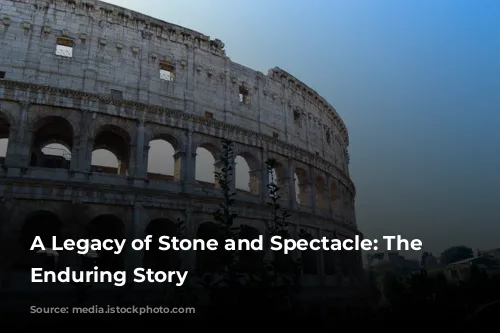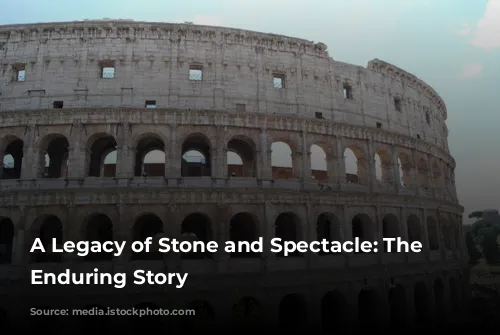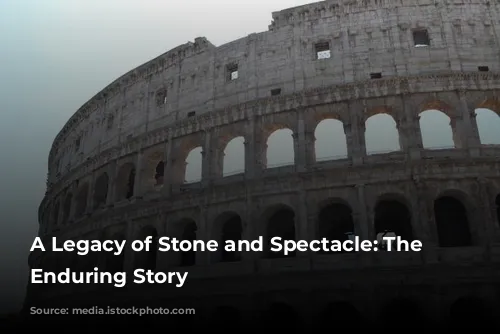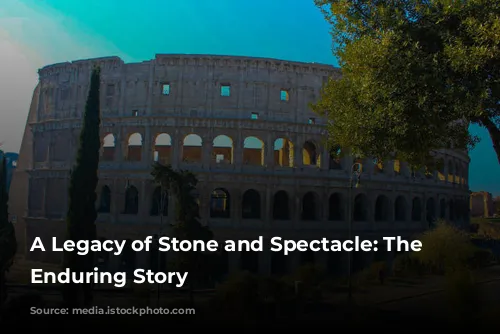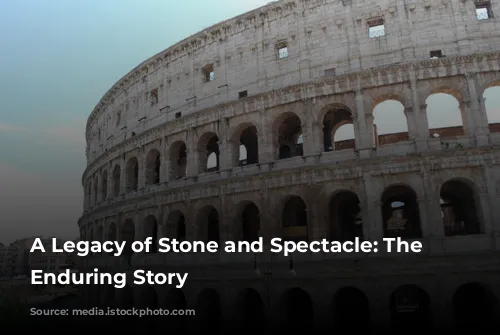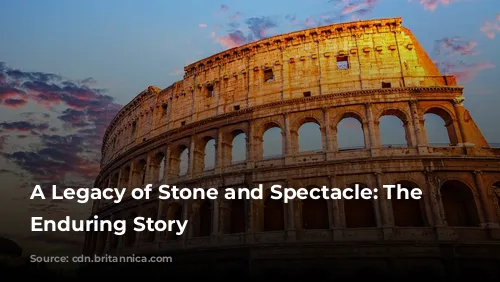The Colosseum, a towering monument to ancient Rome’s architectural ingenuity and engineering prowess, stands today as one of the few mostly intact structures from the Roman Empire. Its significance extends far beyond its impressive structure, as it also serves as a major source of tourism revenue for the Italian government. In 2018 alone, the Colosseum, Roman Forum, and Palatine Hill collectively generated over $63.3 million (€53.8 million), solidifying their position as Italy’s top tourist attraction.
This paragraph highlights the Colosseum’s historical significance and its contribution to modern-day Italy.
A Monument’s Trials and Triumphs: From Glory to Ruin and Back
The Colosseum’s story is not without its trials and tribulations. After the fall of the Western Roman Empire, the once-glorious arena fell into a state of severe disrepair. During the 12th century, the Frangipane and Annibaldi families transformed the arena into their fortress, repurposing its grandeur for their own ends. In the late 15th century, Pope Alexander VI permitted the Colosseum to be used as a quarry, stripping its magnificence for building materials. Over a thousand years of neglect took their toll, but hope arrived in the 1990s when state-funded restoration efforts began to revive the Colosseum’s former glory.
This paragraph details the Colosseum’s decline and eventual restoration, highlighting its resilience despite years of neglect.
A Stage for Power and Entertainment: The Birth of the Colosseum
The Colosseum was built as a grand gesture of imperial revitalization following the turbulent “Year of the Four Emperors” in 69 CE. Emperor Vespasian, like other emperors before him, intended the Colosseum to be a captivating entertainment venue. Its stages would host a dazzling array of spectacles, including gladiator fights, thrilling animal hunts, and even mesmerizing mock naval battles.
This paragraph explains the Colosseum’s original purpose as a venue for entertainment during the Roman Empire.
A Monument Built by Blood and Sweat: The Colosseum’s Construction
Construction of the Colosseum commenced under the reign of Emperor Vespasian between 70 and 72 CE. The completed structure was dedicated in 80 CE by Titus, Vespasian’s son and successor. The Colosseum’s fourth story was added by Emperor Domitian in 82 CE. It is important to note that the arena was funded with plunder from Titus’s conquest of Jerusalem in 70 CE, and it was built by enslaved Jewish people from Judea, a stark reminder of the empire’s brutal reality.
This paragraph details the Colosseum’s construction, highlighting the role of slavery in its creation.
A Giant Among Amphitheaters: The Colosseum’s Physical Form
The Colosseum is an elliptical amphitheater constructed in Rome under the Flavian Emperors of the Roman Empire. It is also referred to as the Flavian Amphitheater. This magnificent structure, built of stone, concrete, and tuff, stands four stories tall at its highest point, measuring 620 by 513 feet (189 by 156 meters). It could accommodate a staggering 50,000 spectators, making it a true marvel of ancient engineering. The Colosseum was renowned for its gladiatorial combats, where the fates of men were decided in a spectacle of blood and courage.
This paragraph provides a detailed description of the Colosseum’s physical characteristics and its capacity.

A Symbol of Imperial Power: The Colosseum’s Location and Purpose
The Colosseum, located just east of the Palatine Hill on the grounds of Nero’s former Golden House, stands as a testament to the shifting power dynamics of ancient Rome. The artificial lake that once adorned the Golden House was drained to make way for the Colosseum, a decision that held symbolic weight alongside its practical benefits. Vespasian, who ascended to the throne from humble beginnings, chose to replace the tyrannical emperor’s private lake with a public amphitheater, a space where tens of thousands of Romans could gather for entertainment and spectacle.
This paragraph explains the Colosseum’s strategic location and its symbolism as a replacement for Nero’s opulent private space.

A Masterpiece of Architecture and Engineering: The Colosseum’s Design and Construction
The Colosseum, unlike earlier amphitheaters built into hillsides for support, is a freestanding structure crafted from stone and concrete. Its construction relied on a complex system of barrel and groin vaults, creating a monumental structure measuring 620 by 513 feet (189 by 156 meters). The lower three tiers are adorned with arcades framed by engaged columns in the Doric, Ionic, and Corinthian orders, a unique design that became a cornerstone of Renaissance architecture. The Colosseum’s primary structure and facade are made of travertine, while the secondary walls are crafted from volcanic tufa. The inner bowl and arcade vaults are constructed from concrete, showcasing the Romans’ mastery of this innovative material.
This paragraph emphasizes the Colosseum’s unique architectural features and its role in influencing later architectural styles.
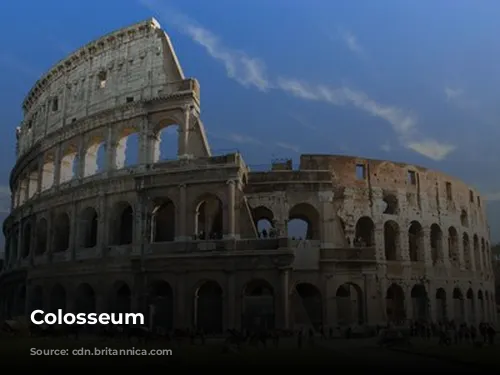
A Stage for Spectacle and Survival: The Colosseum’s Events and Legacy
The Colosseum offered seating for 50,000 spectators, who were protected from the sun by a massive retractable awning known as a velarium. Supported by masts extending from corbels in the Colosseum’s attic story, hundreds of Roman sailors were responsible for manipulating the rigging that extended and retracted the velarium, ensuring the comfort of the audience. The Colosseum hosted a diverse range of spectacles, from intense hand-to-hand combat between gladiators to contests between humans and wild animals. The arena even witnessed mock naval engagements, showcasing the Romans’ theatrical ingenuity. However, the truth of whether early Christians were martyred in the Colosseum remains a matter of debate and speculation.
This paragraph describes the Colosseum’s seating capacity, its retractable awning, and the types of events it hosted. It also acknowledges the uncertainty surrounding the historical accounts of Christian martyrdoms in the arena.
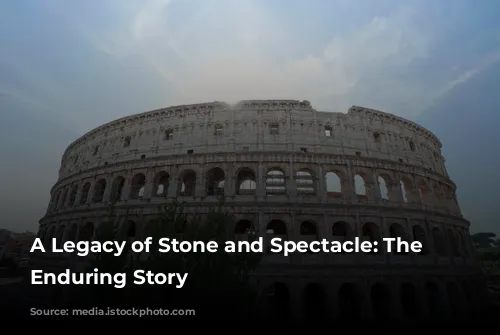
From Glory to Neglect and Renewal: The Colosseum’s Later Use and Preservation
During medieval times, the Colosseum underwent a transformation, serving as a church and then as a fortress for two powerful Roman families, the Frangipane and the Annibaldi. However, the arena’s grandeur suffered from the ravages of time, lightning strikes, earthquakes, vandalism, and pollution. The marble seats and decorative elements were plundered, leaving the site to languish as little more than a quarry for over a thousand years. The Colosseum’s preservation efforts began in earnest in the 19th century, with notable contributions from Pius VIII. In the 1990s, a comprehensive restoration project breathed new life into the ancient monument. Today, the Colosseum stands as one of Rome’s most beloved tourist attractions, welcoming nearly seven million visitors annually. Changing exhibitions dedicated to ancient Roman culture are regularly held within its walls, ensuring the Colosseum’s legacy continues to inspire and captivate audiences from around the world.
This paragraph details the Colosseum’s use during medieval times, its subsequent decline, and the efforts to preserve and revitalize it. It emphasizes the Colosseum’s enduring popularity as a major tourist attraction and its role in promoting ancient Roman culture.
